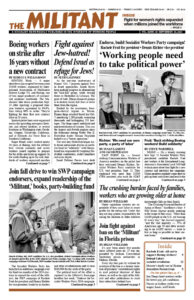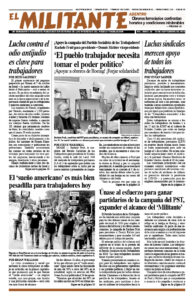I really got a lot out of the feature article in the Sept. 2 issue of the Militant, “Forging a proletarian party in the class struggle today: Socialist Workers Party uses Marxist program and party’s experiences to set course.”
I wanted to add to the very useful section of the article on thuggish violence by Stalinist currents today and their predecessors. The article cites the Maoist Communist Workers Party’s ultraleft and provocative “Death to the Klan” rally in November 1979 in Greensboro, North Carolina, during which five of its members were killed and others wounded by armed Klan and Nazi thugs. That provocation “did real damage to both the fights for Black liberation and defense of constitutional protections,” the article says.
At the time I was a member of the Piedmont branch of the SWP in nearby Winston-Salem and, like many workers in the region, felt those destructive effects on the class struggle.
The CWP’s course deeply damaged a broad union-organizing effort among textile and other workers in the region that developed following the historic victory of the United Steelworkers union-organizing drive and strike by 17,500 shipyard workers in Newport News, Virginia.
Textile mills in North Carolina employed over 250,000 workers. The Communist Workers Party had implanted its members in several. Called the Workers Viewpoint Organization until two weeks before the Greensboro rally, they sought to win support by using their education as doctors and professors to offer medical care to workers while promoting their organization.
They vilified and sought to decertify the existing Amalgamated Clothing and Textile Workers Union and to form independent unions under their own control.
They even more clearly showed their true colors, methods and aims with armed anti-Klan actions in the state. The Greensboro rally of 100 people was organized in the largely African American Morningside housing project. Some CWP members were armed. When the Klan caravan arrived, the protesters kicked their cars and hit them with signs. It’s not known who fired the first shot.
During the rightists’ rampage, which police and FBI agents knew was coming, up to 40 racist and anti-working-class Klansmen and Nazis calmly shot up the crowd and fired into the project for almost two minutes. The police, who had followed the Klan caravan into the city, had disappeared. Four of the five CWP members killed had worked in the textile mills.
The provocative anti-Klan rally and its inevitable bloody results had a chilling effect on workers in the state seeking to mobilize for union recognition, leading to the decline of the unionization drive. It also led to rightist and Klan death threats against SWP members in the nearby union-organized factory where I was working.

